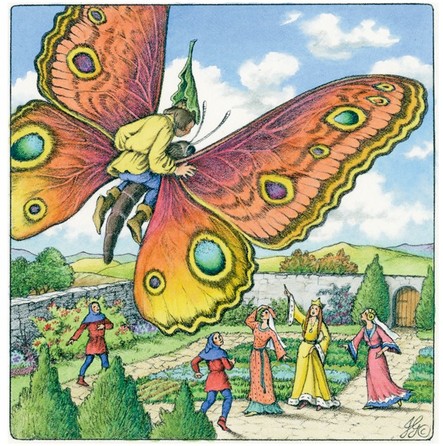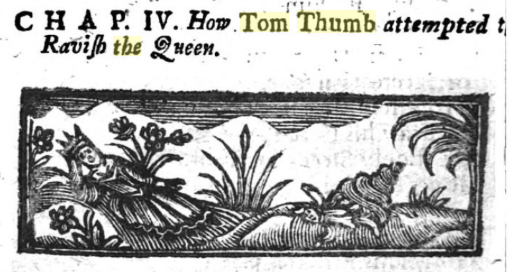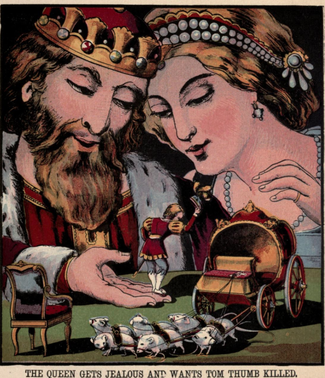|
The following post deals with some mature subjects. Tom Thumb used to be a story for adults. The oldest surviving version was printed in 1621 and attributed to Richard Johnson; however, the one that has survived longest is its successor, a version in verse entitled Tom Thumbe, His Life and Death. This version trims down many of Johnson’s embellishments – it leaves out magical gifts from the Fairy Queen and a battle with Gargantua the giant. A childless man goes to Merlin, confiding his desire for an “heire, though it might be/ no bigger than his Thumbe.” Merlin obliges and in a matter of minutes, Tom is produced. There’s a joke about flatulence, and Tom is not only eaten whole by a cow but emitted out the other side “all besmeared,” and later is swallowed by a giant and vomited up. So this version is not exactly G-rated. Anyway, Tom makes his way to court, where he is greatly beloved by King Arthur, his queen, and all the knights and ladies. Tragically, he is exhausted by jousting, sickens and dies, and is greatly mourned. The end. Except that it wasn’t. Some time afterwards - like, 70 years afterwards - there were two new chapters printed. I am not sure when the new version came about, but according to James Orchard Halliwell (who reprinted it), it was written around 1700. I can find no record of the specific version, but there are scattered contemporary references to it. In 1711, in William Wagstaffe’s Comment upon the History of Tom Thumb, he mentions “That there has been publish'd Two Poems lately, Entitled, The Second and Third Parts of this Author, which treat of our little Hero's rising from the Dead in the Days of King Edgar.” There's a similar mention in the preface to the play "Tom Thumb the Great, or the Tragedy of Tragedies," in 1731. The identity of the author of the two "new" chapters is insignificant. I put new in quotes because most of it is simply the original repeated. However, they soon evolved into part of the Tom Thumb mythos, and brought with them a new, very dark element that for me casts a shade over the whole fairytale. First it reprints the entirety of “The Life and Death of Tom Thumb.” However, at the end, it is revealed that Tom didn’t die, but was taken by the Fairy Queen to her realm, where he would reign for two hundred years. He returns to the human world during the reign of King Edgar. (Edgar was a historical king, and these chapters may have contributed to a theory bopping around that Tom Thumb was based on his real-life court dwarf.) He makes his entrance by falling into the king’s firmity in the middle of a meal, offending the court in the process. (Firmity, or frumenty, is a kind of porridge and a popular medieval dish.) He is then swallowed by a miller and a salmon, in that order, before finally making peace with King Edgar and becoming a favorite of the court once more. While out hunting, he’s attacked by a cat and is so badly wounded that the Fairy Queen takes him to her realm once more. Now Part the Third begins, with Tom being returned to the human world once more. This time he falls into a close-stool pan, i.e. a chamber pot, which has apparently not been cleaned out. I’m questioning the Fairy Queen’s attachment to him at this point. The current king is Thunston. This name appears to have been made up entirely. Once recovered from his ordeal, Tom introduces himself, and Thunston thinks he’s the greatest thing ever. He makes Tom his page and showers him with gifts, including a coach drawn by six mice. However, Tom grows proud and ambitious, and begins to lust after Thunston’s queen. When the queen goes to rest in the garden and falls asleep, Tom spies on her from a snailshell and, in a very disturbing sequence, prepares to assault her. Though it's not explicit, you can tell what's happening. He may be tiny, but the scene is still deeply unsettling. She wakes up just in time and demands to know what he’s doing. Tom “made but a Jest, and laugh’d as he rose.” So he was in the act to the point where he has to stand back up, and he still laughs it off. The furious Queen now demands that he be executed. Not just punished, not banished; nothing suffices but that he die. Tom flees on a butterfly, but is captured and brought to trial. He makes a touching speech that wins over nearly all the Court, except of course the Queen “whom Rage and Fury did transport, no one could intervene.” Those dang women, getting mad when people try to rape them. Tom’s imprisoned in a mousetrap, where a cat finds him and accidentally breaks him out. Tom runs away, only to run into a spider’s web and be bitten. He dies of his injury, but his legacy lives on. Poor tragic little rapist Tom. Most commentators seem to have found these two chapters a poor addition to the story; however, many of the new elements stuck around in later retellings. These include Tom's return from fairyland, and his death via spider-bite That was around 1700. (Roundabout the same time this story was published, in the play Tragedy of Tragedies, Tom Thumb has an affair with King Arthur’s queen, here named Dollalolla.) But in the 1800s, Tom Thumb began to become a children's story. That meant a few things, like defecating cows and farting tinkers, needed to be removed or at least toned down. In many versions Tom became less of a trickster and more of a proper little man. And he had to be sympathetic. As a result of this facelift, the final conflict needed to change drastically. Around 1835, in “The Diverting History of Tom Thumb,” the queen plots to have Tom killed not because he's wronged her, but because he gets more attention than she does. Her motive changes from righteous fury to petty jealousy. The rape scene is gone. Tom is wholly innocent, and the queen is a villain. Dinah Maria Craik Mulock’s Fairy Book (1863), gives the trouble an even more specific cause - the tiny coach that Thunston gives to Tom. The queen, envious of this specific gift as well as the attention in general, “resolv[es] to ruin Tom” and tells the king that he was insolent to her. Her jealousy over the coach is also the catalyst in the 1880s' “Story of Tom Thumb” (published by McCoughlin Bros.) Here the queen is even worse - she weaves multiple lies and insists on Tom's torture in a mousetrap. Her complaint is always that Tom is disrespectful, but depending on how you read it, there may still be the implication that she's accusing him of rape. In at least some versions she uses the word "saucy," which can have erotic connotations.
Along with this change, there was another wrinkle. People started to simplify the stories, and the queen's identity changed. In Joseph Jacobs’ English Fairy Tales (1890) “The History of Tom Thumb" is near-identical to Mulock’s version, except that Thunston and his wife are replaced by Arthur and Guinevere. In The History of Tom Thumb by Helen and Bruce Gentry (1934) it’s also Arthur’s queen; the same in a 2010 retelling by Amy Friedman and Meredith Johnson. A far cry from the 1630 version, where Tom was a great favorite of Guinevere. For this reason, the story bothers me. The current villain of the tale has roots going back to a story where she is a victim of assault. By the hero. I don't know why the rape was added, but it was erased to make Tom look better and make the story more child-appropriate. Even before it was erased, it seems like the reader was still supposed to cheer for Tom and boo the queen. And making it more child-appropriate is ironic, because Tom Thumb is, at his core, a child. He is an infant who never really grows up. In other cultures the story ends with him returning to his home and the arms of his parents; in Tom's version, he tragically dies young. Some versions do have him become a man, take a wife, and become wealthy and successful. The three-part version has this happen, but in a twisted manner; instead of marrying and starting his own family, he is consumed by lust and it becomes his downfall. So all I can do is wonder a) who wrote this and b) why on earth they thought it was a good idea?! Text copyright © Writing in Margins, All Rights Reserved
0 Comments
Leave a Reply. |
About
Researching folktales and fairies, with a focus on common tale types. Archives
July 2024
Categories
All
|
Writing in Margins



 RSS Feed
RSS Feed
